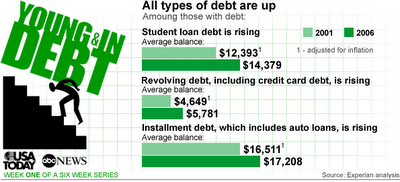
USA Today, in a partnership with ABC News offers a 6-week series, Young & In Debt, featuring an exclusive poll with the National Endowment for Financial Education and exclusive database analysis of credit reports of 3 million twenty-somethings by Experian.
The series, running from November 20 to December 29, 2006, will profile five twenty-something readers and their financial challenges. Articles will appear in USA TODAY on Mondays and Fridays, addressing issues such as: saving for a first home, setting financial goals, obtaining insurance, paying off college debt, online components include video, quizzes and financial calculators
Some data highlights:
This generation of twentysomethings is straining under the weight of college loans and other debt, a crushing load that separates it from every previous generation.
Nearly two-thirds carry some debt, and those with debt have taken on more in the past five years, according to an analysis of the credit records of 3 million twentysomethings that Experian, the credit-reporting agency, did for USA TODAY. Their late payments are rising, and they're more likely to be late than other Americans are.
Nearly half of twentysomethings have stopped paying a debt, forcing lenders to "charge off" the debt and sell it to a collection agency, or had cars repossessed or sought bankruptcy protection.
High debt loads are causing anxiety, too. A poll of twentysomethings by USA TODAY and the National Endowment for Financial Education (NEFE) found 60% feel they're facing tougher financial pressures than young people did in previous generations. And 30% say they worry frequently about their debt.
Although the percentage of people ages 22 to 29 with debt has declined, their total debt is up 10%, to an average $16,120 as of Aug. 1, compared with five years earlier, Experian's analysis found. Every type of debt — from credit cards to college to personal loans — has risen.
Student-loan balances rose 16% to an average of $14,379; revolving debt, including credit cards, surged 24% to $5,781; and total installment debt, including student and personal loans, rose 4% to $17,208. (Comparisons are adjusted for inflation.)
Among all twentysomethings, the fastest-growing group owes $20,000 or more in student-loan debt. Though it's a small group, its proportion has doubled in the past five years to 3%.
Debt has forced some young people to change their career plans. Of those surveyed, 22% say they've taken a job they otherwise wouldn't have because they needed more money to pay off student-loan debt. Twenty-nine percent say they've put off or chosen not to pursue more education because they have so much debt already. And 26% have put off buying a home for the same reason.
A smaller percentage say they've put off marrying (11%) or having children (14%).
The Boomerang Generation — young adults who return to live with their parents — is real, too. In the poll, of 910 twentysomethings, 19% said they've moved back with parents to cut costs. The 2000 Census found that more than 25% of 18- to 34-year-olds had moved back in with family at the time the Census was taken.
Experience Inc., which provides career services to link college grads with jobs, found that 58% of twentysomethings it surveyed in July had moved back home after college. Of those, 32% stayed for more than a year, according to its survey of 320.
"The reliance on family for this generation is very, very different from prior generations," says Jennifer Floren, CEO of Experience. "They're living under the shelter — financial and otherwise — of Mom and Dad for much longer. "
Many young people fear they won't be able to count on Social Security or on company pensions. Meantime, they're being urged to save early for their retirement.
Yet many can't, and most aren't. Fifty-five percent aren't saving in either an individual retirement account or a 401(k) account, and 40% don't have a savings account they contribute to regularly, according to the USA TODAY/NEFE poll.
 Generation Debt? Or Generation Whine? What exactly is tougher about the financial challenges facing today's young adults?
Generation Debt? Or Generation Whine? What exactly is tougher about the financial challenges facing today's young adults?
•Skyrocketing tuition. The average price of college has grown much faster than the rate of inflation. Average annual tuition at public four-year colleges and universities is $5,836 in 2006-07, up 268% from 1976-77, according to the U.S. Education Department and the National Center for Education Statistics. Private college tuition is up 248% to $22,218 a year.
•Declining student grants. Though total federal student aid has grown sharply, so has the proportion of people in college. In 2004, 67% of high school graduates enrolled in college; in 1972, only 49% did. As a result, student grants cover only 39% of the costs of a four-year college today, compared with nearly 80% in the mid-1970s, the College Board says.
•Soaring student-loan debt. Students have generally made up the gap between what colleges charge and what they can afford by borrowing. The percentage of students who borrowed for college jumped to 65% in 2000-01 from 34% in 1977, the National Center for Education Statistics says.
And they use credit cards to help pay for books and other items. Half of all graduates in 2004 used credit cards for school expenses, the American Council on Education found.
•Flat wages. Once students graduate, jobs don't pay what they used to.
Thirty years ago, a male college graduate could make the equivalent of $51,223 a year in 2004 inflation-adjusted dollars. In 2004, he earned less: $50,700, according to the NCES. Wages for women, though, have risen.
•Rising home prices. It takes a greater portion of the average income to buy a median-price home today. In 1970, it was 17%; in 2005, 22.4%. The median price of a home was $23,000 in 1970. Adjusted for inflation, that's $115,770 — barely more than half the median price of $219,000 in 2005.
Share ideas that inspire. FALLON PLANNERS (and co-conspirators) are freely invited to post trends, commentary, obscure ephemera and insightful rants regarding the experience of branding.
Tuesday, November 21, 2006
Bankrupt!: Young And In Debt
Subscribe to:
Post Comments (Atom)

No comments:
Post a Comment